The takeover of the abbots of the monastery of Fitero in the Ancien Régime (and II)
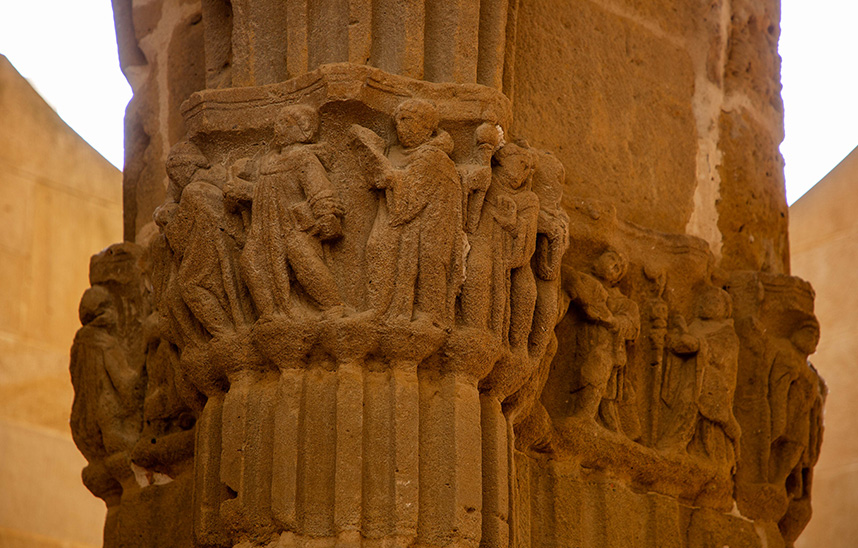
PhotoJ. Latorre/Capitel corrido del claustro bajo del monasterio, made by 1545 by Baltasar Febre o de Arras and appraised by Pierres del Fuego.
A capital from the lower cloister: abbey power in images
In a running capital of the lower cloister of the monastery of Fitero, made for 1545 by Baltasar Febre or de Arras, the solemn procession of the abbot in the town of his jurisdiction is narrated, in what comes to be a demonstration of his power, sculpted in stone, as if he wanted to leave testimony in images of having defended his authority in the noisy lawsuits that were litigated in the committee Real around the jurisdiction of the abbey in those years. In this regard, it should be remembered that the monastery obtained by judgments (1546) and review (1547), in the committee Real de Navarra, the highest organ of justice, the recognition of the jurisdiction leave and median over the town of Fitero, which some neighbors tried to take away from it since 1542. It would never be superfluous, together with the procedural evidence, that of an image that is always worth more than many words.
In the relief we find a procession with acolytes, cross, scepters, ceroferarios, singing monks, psalmists, the deacon carrying the case with the papal document and the abbot with his crosier, followed behind by the mayor with his staff, regiment and people. It is, undoubtedly, a sermon sculpted in stone that speaks with its images of the abbot's inauguration in those centuries of the Ancien Régime. The fundamental elements of that moment are not lacking: procession, monks with their cogullas, the abbot still without all the insignia of the pontifical that would not be achieved until 1560, the mayor with the discussed rod and attired with the proper attire with the ferreruelo and the people. If what is being recreated is, as one might suppose from the chronology, the actual inauguration of Friar Martín de Egüés II in 1540, the pontifical document that made him his uncle's successor in the abbey had already been on the abbey's file for some time, since he had obtained it in August 1538.
With the quadrennial abbots
As Goñi Gaztambide recalls, between 1644 and the monastic exclaustration, the abbots were elected every four years. The first two were elected among monks of the Congregation of Castile, outside the house of Fitero, and Philip IV followed the same tactic in the other Navarrese monasteries that protested, since in the internship their aggregation to the Aragonese Congregation was annulled. In exchange for a hefty donation to the monarch, the latter agreed that from now on the Navarrese abbeys would be provided with professed monks from their respective monasteries, chosen from a list of three.
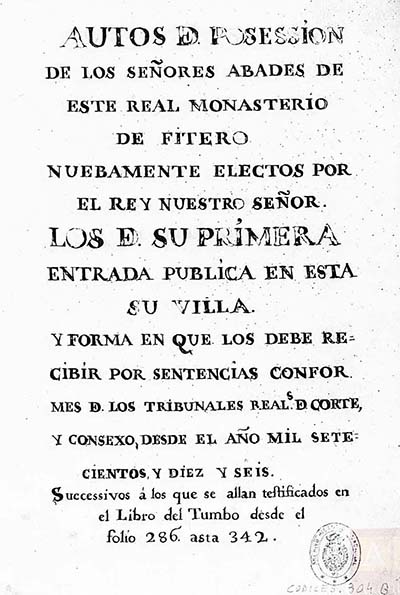
Title page of the book of the abbots of Fitero (1716-1830) preserved in the file National Historical Archive.
The first of the quadrennials was Fray Atanasio del Cucho, conventual of Santa María de Sobrado in Galicia, who arrived in September 1644, after the ringing of bells and the arrival of the regiment to the church to gather the Cistercian community to go to the Humilladero. In this case it was necessary to wait a long time until the new abbot arrived, he was welcomed and, according to the custom, he was dressed in pontifical dress and proceeded to sing the Te Deum and to make the procession to the church, with captains and guildsmen. In the temple the Blessed Sacrament was taken out, something generalized in that century of the Counter-Reformation, he reserved it, several documents were read, in this case the royal appointment certificate that was placed over the heads of the local authorities as a sign that they would comply with its contents.
The next quadrennial abbot, Friar Pedro Jalón, son of the abbey of Santa María de Nogales, took possession on September 21, 1648, with the oath before the community and the imposition of the insignia of the pontifical by the monk delegated by the vicar general of the Congregation of Castile and Aragon, while the cantor intoned the Te Deum. This act in conventual chapter was already a novelty with respect to what we have been seeing up to now. Immediately, a procession was made through the overcloisters to the choir loft and there, the abbot kneeling, sat down on the abbey chair "in sign of true possession, which he took without impediment or contradiction from any monk". From there they returned to the conference room Capitular where he received the obedience of all the monks and later they approached the porter's lodge, received his keys, opened and closed it, doing the same at the doors of the abbey palace. The public reception was preceded by a letter sent by Friar Pedro, from the Baths, to the town councilors informing of his arrival between four and five o'clock in the afternoon. When the time came, the bells were rung, the aldermen and numerous neighbors came to the church, gathering the Cistercian community to go to the Humilladero, where they awaited the arrival of the abbot. When the abbot arrived, the aforementioned ceremonial was repeated in all its details.
From this occasion in 1648, the testimonies of possession were always twofold, on the one hand with the celebration within the walls, within the monastic premises with the canonically established and, on the other hand, with regard to the monastic lordship, in the public ceremony with the civil authorities and the people, in different places of the town.
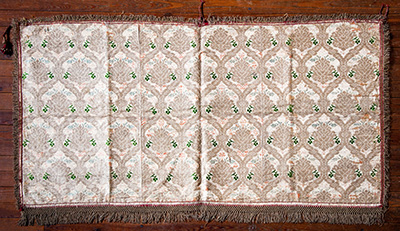
Guild cloth from the monastery of Fitero, second half of the 18th century. Photo J. Latorre
In 1652 the first son of the monastery of Fitero, Friar Benito López, took possession of the abbey, following in everything done with his predecessor. In the letter he addressed to the regiment, from the monastery of Tulebras, he noted the circumstance of being the first abbot to leave the community in the quadrennial period. The reception took place in the humilladero.
From 1656 onwards, the humilladero is no longer mentioned, but is instead called the cross of the Calleja or portal de la cruz de la Calleja, closer to the town center, specifically on its northwest flank. An exceptional witness will refer to this fact in a lawsuit to which we will refer immediately. He was Friar Ignacio de Ostabat (1650-1724), abbot in two quadrennia, secretary of the Congregation of Aragon and Navarre, deputy in the Cortes of Navarre and expert in law and history. Fray Ignatius pointed out the change of place and the arrival of the abbots by car, starting from the designation of the quadrennial abbots. Although in the internship it did not take place in 1644, but in 1656.
As we have indicated in the Libro Tumbo and in another special book dedicated to the topic, which begins in 1716, the takeovers are preserved. The last recorded certificate is from 1830, on the occasion of the possession of the abbey of Friar Bartolomé Oteiza, limiting the act to within the walls, in the church, the choir and the chapter house conference room , without public acts. Apparently, the last possession with the traditional uses and customs and the public ceremony of reception with the municipal authorities took place in 1804, when Fray Jerónimo Bayona entered in possession of the abbey in the place that they call "the door that they call of the cross of the Calleja".
A lawsuit in 1716
In spite of everything being protocolized and with sentences ordering various details of the reception by the Royal committee of Navarre -especially one from 1594-, as in other aspects and events, any small detail or innovation gave rise to dissensions and lawsuits. One of the latter was litigated in the Navarrese courts between 1716 and 1717.
On the occasion of the reception of Friar Ángel Ibáñez, in 1716, the regiment agreed to go out to the usual place, the cross of the Calleja, to pick up the abbot and the community and return together to the church. The appointed time was between three and four o'clock in the afternoon. After vespers, the civic-religious retinue went to the appointed place, where an altar had been placed with the Holy Cross -possibly the reliquary of the Lignum crucis-, the image of Our Lady of the Conception, a Marian invocation voted patroness of the town of Fitero in 1643, and the pontifical insignia. When the abbot arrived in his car, the mayor and the aldermen made the corresponding venias, approaching the car, without the prelate getting out of it. However, the ordinary mayor did not do so, before which the abbot warned that he did not admit any innovation in this respect. In the proceedings of the process the uses and customs are recalled, basically, procession, pontifical lining, Te Deum, seat in the church, reading of the Royal Decree that was kissed and imposed on their heads by the authorities.
The sentence issued in 1717 supported the monastery's arguments, clearly stating that without the abbot getting out of the car, the mayors and aldermen would welcome him and, returning to their posts, would wait for the prelate to dress as pontifical to continue with all the uses and customs.
Material memories
Some of the objects with which the ecclesiastical jurisdiction of the abbot was visualized and, therefore, were present at the entrances of the new abbots and successive inaugurations, have been preserved to this day. As we have pointed out, from 1560 onwards, the abbot of Fitero could already display his power and image as such, with numerous privileges, among them that of using "pontifical chair in the church, crosier, mitre, pectoral, ring and guild". Regarding this last element, let us remember that when the abbots wore pontifical vestments and were preceded by ecclesiastics carrying the guild cloth, which is still preserved, along with the miter, chirotecas and caligas, among the collection of fabrics of the monastery. As is known, the gremial was a rectangular cloth used in the pontificals of the bishops, according to the ancient Roman Ceremonial of bishops both to cover their knees in the offices inside the church, and for the processions outside the temple.
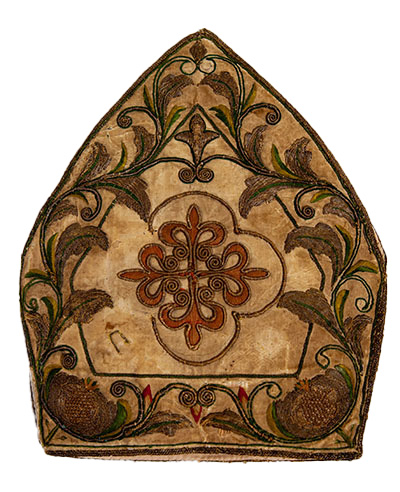
Mitre of the abbot of Fitero from the 18th century. Photo J. Latorre
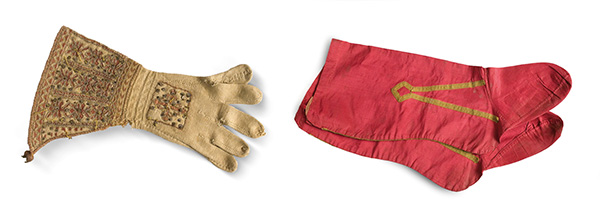
Quitoteca and caligas from the trousseau of the Fitero abbots of the 18th century. Photo J. L. Larrión
The gremial preserved in Fitero dates from the second half of the 18th century. The pectoral, which was stolen by Father Planas, a monk from the Abbey of Montserrat, who came to make himself position of the inheritance of the parish priest of Fitero, Friar Joaquín Aliaga (†1898), did not have the same fate. Claiming the pectoral as belonging to the parish, Father Planas added that in exchange for the pectoral he had left a clock for the sacristy.
